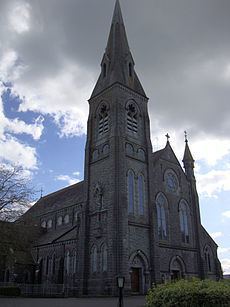Population- Catholics 36,000 Rite Latin Rite Area 2,486 km² Metropolitan archbishop Michael Neary | Denomination Roman Catholic Patron saint Brendan | |
 | ||
Established Bishopric in 550; Diocese in 1111 | ||
The Diocese of Clonfert (Irish: Deoise Chluain Fearta) is a Roman Catholic diocese in the western part of Ireland. It is in the Metropolitan Province of Tuam and is subject to the Metropolitan Archdiocese of Tuam. The current Bishop is the Most Reverend John Kirby who was appointed by the Holy See on 18 February 1988 and (ordained bishop) on 9 April 1988.
Contents
Geographic remit
The diocese covers almost the whole of East Galway, with one parish (Lusmagh) in County Offaly while the parishes of Taughmaconnell, Creagh and the half-parish of Ballinasloe lie in County Roscommon. This was the ancient territory of the kingdom of Uí Maine (Hy-Many), as it existed when the diocese was formed. In fact, the bishop of the diocese was sometimes referred to as the Bishop of Hy-Many. The major towns in the diocese are Ballinasloe, Loughrea and Portumna.
The cathedra is currently located at Loughrea but was historically Clonfert Cathedral.
Early history
The bishopric was established in A.D. 550 and the diocese in 1111. The early Irish monastery and school of Clonfert, founded by Saint Brendan, was the dominant ecclesiastical centre in the area and an important centre of learning in the early Irish church. Cummian, an important theological writer was from there. It was also deeply involved in the eighth century spiritual reform movement of the Céli Dé.
Saint Brendan's fame as a seafaring missionary contributed to its pre-eminence in later times and led to its choice as an episcopal see in the twelfth century. Like most dioceses in Ireland, the present Diocese of Clonfert had its origin in the Synod of Rathbreasail in 1110, reaching its final form at the Synod of Kells in 1152 when it was made a suffragan of the Archdiocese of Tuam.
Feudal period
In 1170, the Annals of Clonmacnois record that "there was a great convocation of the clergy of Ireland at Clonfert by commission from the Pope for the reformation of certain abuses of a long time used in Ireland", which was presided over by Saint Laurence O'Toole presided as papal legate.
In the early 13th century its bishop was one of those appointed by Honorius III to investigate a dispute over the election of the Bishop of Ardfert. Later that century it was provided with John, a bishop of Italian birth — one of the very few occasions when this happened in Ireland. Bishop John remained in Clonfert for many years until he was translated to Archbishop of Benevento in the 1290s. Because of the quality of its land, a century later it was judged by Rome to be richer than its metropolitan see and ordered to pay 300 gold florins as the tax on the accession of a new bishop while Tuam had to pay only 200.
The diocese was divided into four deaneries, Clonfert, Loughrea, Urrachree and Duniry, having 15 rectories and 39 vicarages with a chapter and offices after the Norman pattern. Four houses of Canons Regular and four of Canonesses were established in the Irish deaneries.
In the 14th and 15th centuries, bishops introduced the mendicant orders: the Franciscans to Kilconnell, Kilnalahan and Meelick, with their 3rd Order to Clonkeenkerril and Kilbocht; the Dominicans to Portumna, with their 3rd Order to Kilcorban; and the Carmelites to Loughrea.
Kingdom of Ireland
The Canons disappeared with the English Reformation, but the Mendicants remained and were an important factor in maintaining religion structures during the Penal Laws until, with the establishment of Maynooth College in 1795, the flow of secular priests became adequate again. Evading the law by registering as parish priests in 1704, they served one-third of the parishes throughout the eighteenth century.
Catholic Emancipation
In 1704, the diocese had forty-one parishes but by 1800, these were amalgamated into twenty four. The chapters disappeared after Catholic Emancipation, when the more severe provisions of the Penal Laws were relaxed. There followed a period of church building. Churches were erected in Ballymacward and Ballinasloe, the latter designed by McCarthy and Pugin. Landlord intransigence prevented the building of a cathedral in Loughrea until 1897 when Bishop Healy laid the foundation stone, which was fortunate because the era of the Celtic Revival and Irish Stained Glass had begun, with happy results in its interior decoration.
The Sisters of Mercy were brought to Loughrea in 1850 by Bishop Derry and spread to five towns in the diocese, operating primary and secondary schools, industrial schools at Loughrea and Ballinasloe and a domestic economy school at Portumna. They also staffed the workhouse hospitals in Loughrea, Ballinasloe and Portumna and latterly the county home in Loughrea. The Sisters of Mount Carmel, who have been in Loughrea since the 17th century, conducted a school there up to 1860 but have since been an enclosed order. In 1945 Bishop Dignan introduced the Franciscan Missionaries of the Divine Motherhood to Ballinasloe, where they built Portiuncula Hospital, which has been enlarged many times since and is now a general hospital under the Western Health Board.
The diocesan seminary, begun at Loughrea by Bishop Derry in the 19th century, was succeeded by St. Joseph's College at Cartron, at Esker and finally at Garbally Park since 1924. The Dominicans, who had come from Athenry, ran a college at Esker for a time, where now the Redemptorists have a house for retreats.
Ordinaries
The following is a basic list of the post-Reformation Roman Catholic bishops.
